from obsessed with frida kahlo
[youtube=http://www.youtube.com/watch?v=_RrS5xvfRXg]
no sos frida kahlo, 2007
[youtube=http://www.youtube.com/watch?v=dsHCjxKoYc4]
puppets, 2007

from obsessed with frida kahlo
[youtube=http://www.youtube.com/watch?v=_RrS5xvfRXg]
no sos frida kahlo, 2007
[youtube=http://www.youtube.com/watch?v=dsHCjxKoYc4]
puppets, 2007

My newest partner in crime is the talented, witty, godzilla and pikapika lovin' Chicano artist and curator Rio Yañez. I first came across his Ghetto Frida two years ago, while working on the project Obsessed With Frida Kahlo. Immediately I felt some sort of cosmic connection-not to Ghetto Frida- but to her creator. And then to make matters worse better, I found out that he is the son of one my biggest heroes- Yolanda Lopez!There was really no option other than collaboration. It was fate.Last month we finally initiated our long distance partnership through a tweet. Since then we have been communicating through TwitPic, Facebook, YouTube, phone calls and texts, and of course mutual shouts in interviews on the blogosphere (mine to Rio & Rio's to me.)Here are a few examples of Rio's recent work:
"I’ve been twittering for about a week now at http://twitter.com/rioyanez. I signed up as a way to contact Amber Rose after she started writing and posting about the portrait I created of her. I have to say, the most exciting aspect of twitter is the way people distribute images. The short urls for twitpics that often pop up on tweets evoke a sense of curiosity in me; more so than the many thumbnails that can be found on facebook. I think the lack of a thumbnail is more alluring and it forces you to chose to see the image or not, there’s no middle ground of a provided preview." (from his blog)
"Artist Curator Rachel-Anne Palacios flanked by Zitlalix and I. I created this portrait to thank Rachel for including me in the recent Frida exhibit she curated and to join the many artists who are on display on the walls of her apartment" (from flickr)
These images represent my first foray into my Raza Zombies series. They were inspired by the single best mainstream comic book of the 21st century: Marvel Zombies. Marvel Zombies re-imagines classic superheroes as flesh eating zombies. After reading it I felt compelled to do some zombie transformations on a few of my own personal heroes. More to come. (from flickr)[youtube=http://www.youtube.com/watch?v=1AhRQrJ7ePg]
Video of Gomez Peña setting the record straight for Rio regarding his Facebook presence.
[youtube=http://www.youtube.com/watch?v=QycIf6uKRd0]
Rio's Ghetto Frida Mural in the Mission District
stay tuned for more...
I was interviewed on the Latino Blog Directory site Blogaderaclick here for full interview:
 [more]check out other Blogadera interviews with Carrie Fergerson and Jo Ann Hernandez
[more]check out other Blogadera interviews with Carrie Fergerson and Jo Ann Hernandez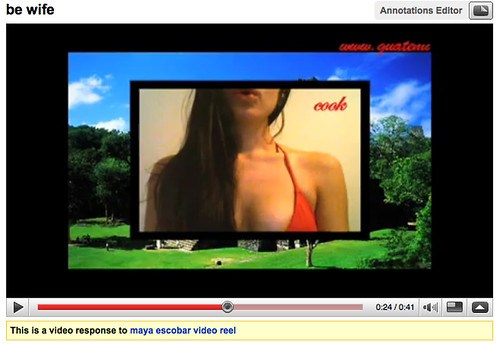
In October of 2006 my rabbi started blogging. While trying to comment on one of his posts, I accidentally registered my own blog. Within hours of posting a comment, my name began appearing in Google searches. I was now linked to the post I had commented on, previous posts my rabbi had written, comments left by other users and the posts they had written elsewhere within the blogosphere. The rapidity with which I was branded, not only by my own online activity, but also by the online activity of others, seemed incomprehensible.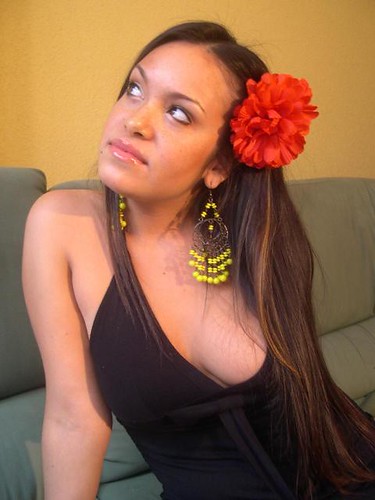 I thought about this phenomenon in relationship to, the images that my friends and I had posted on Myspace throughout that year. I unknowingly went from being slightly annoyed and simultaneously amused by the phrase "take a picture of me for my Myspace", to it becoming completely natural and almost organic to document every moment, every outing, every time my friends and I put on make up, and to take pictures for Myspace. I saw this behavior even further exaggerated in the high school students I was student teaching. Their conversations were dominated with events that had transpired on Myspace, and when they were not talking about Myspace they were taking pictures for Myspace.When we talked about the factors that contributed to the construction of their individual and collective identities, my students were quick to bring up their style of dress, group of friends, the neighborhood they lived in, and the way they spoke. Yet not a single student referenced their online activity, the pictures they posted, the groups they joined, the comments they left on each others pages. I wondered why it was, that they were so aware of and adept at reflecting upon their experiences in the material offline world, but failed to mention the social network that played such a major role in their day-to-day lives.DECONSTRUCTING PERSONAL IDENTITY
I thought about this phenomenon in relationship to, the images that my friends and I had posted on Myspace throughout that year. I unknowingly went from being slightly annoyed and simultaneously amused by the phrase "take a picture of me for my Myspace", to it becoming completely natural and almost organic to document every moment, every outing, every time my friends and I put on make up, and to take pictures for Myspace. I saw this behavior even further exaggerated in the high school students I was student teaching. Their conversations were dominated with events that had transpired on Myspace, and when they were not talking about Myspace they were taking pictures for Myspace.When we talked about the factors that contributed to the construction of their individual and collective identities, my students were quick to bring up their style of dress, group of friends, the neighborhood they lived in, and the way they spoke. Yet not a single student referenced their online activity, the pictures they posted, the groups they joined, the comments they left on each others pages. I wondered why it was, that they were so aware of and adept at reflecting upon their experiences in the material offline world, but failed to mention the social network that played such a major role in their day-to-day lives.DECONSTRUCTING PERSONAL IDENTITY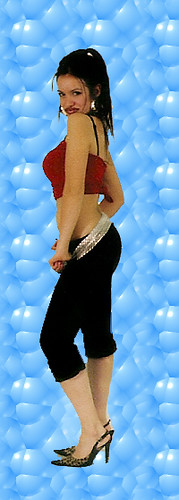 (today) I am referring to myself as a performance artist, Internet curator, and editor. I create and (concurrently) perform multiple online identities, by sampling from different representations of existing cultural discourses. I fragment my personal experiences and invite others to join in, and modify and regroup those fragments. By doing this I hope to share the process through which I deconstruct and reconstruct my individual conception of self, so that others can do the same in their lives.In the series Acciones Plásticas I performed representations of five constructed characters: a religious Jewish woman, a spoiled Jewish girl, a ghetto Latina, a sexy Latina professor, and a Mayan woman. I created low quality YouTube video blogs for four of the characters, the Mayan woman did not have a video, as she would not have had access to YouTube technologies. The videos were strategically placed on popular social networking sites, including YouTube and MySpace. The layout of YouTube contextualized the videos and framed them with user comments and similarly tagged user content. Jewish Girls was picked up by a popular left-wing Jewish blogging site Jewschool, and soon entered the Jewish Blogosphere where it was referred to as the JAP. This repositioning shifted the focus from the portrayal of multiple interwoven identities to a depiction of the Jewish American Princess. The JAP became how people knew my work, validating me while simultaneously conflating my identity with that of this particular character.
(today) I am referring to myself as a performance artist, Internet curator, and editor. I create and (concurrently) perform multiple online identities, by sampling from different representations of existing cultural discourses. I fragment my personal experiences and invite others to join in, and modify and regroup those fragments. By doing this I hope to share the process through which I deconstruct and reconstruct my individual conception of self, so that others can do the same in their lives.In the series Acciones Plásticas I performed representations of five constructed characters: a religious Jewish woman, a spoiled Jewish girl, a ghetto Latina, a sexy Latina professor, and a Mayan woman. I created low quality YouTube video blogs for four of the characters, the Mayan woman did not have a video, as she would not have had access to YouTube technologies. The videos were strategically placed on popular social networking sites, including YouTube and MySpace. The layout of YouTube contextualized the videos and framed them with user comments and similarly tagged user content. Jewish Girls was picked up by a popular left-wing Jewish blogging site Jewschool, and soon entered the Jewish Blogosphere where it was referred to as the JAP. This repositioning shifted the focus from the portrayal of multiple interwoven identities to a depiction of the Jewish American Princess. The JAP became how people knew my work, validating me while simultaneously conflating my identity with that of this particular character.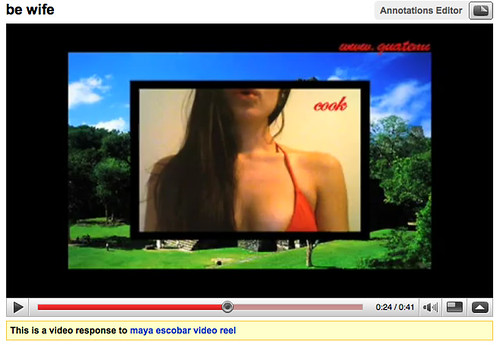 One of the strategies that I employed to counteract idea of "me as The JAP" was to group videos from the series Acciones Plásticas together with three other Youtube videos in a video reel of my work. The first video in the reel, el es frida kahlo is me dressed as Frida Kahlo where I violently scream I am Frida Kahlo! In second video Be Wife, I wear a bright red bikini top in front of an image of a Mayan temple in Tikal. Traditional Guatemalan marimba music plays in the background, while red text scrolls across the top reading Guatemala's finest export. The third video Que Sencilla, features me as a little girl, who is being coaxed by an off-camera male voice to perform a dance for the camera.Someone who is expecting to see a Jewish American Princess, is instead greeted with an enraged
One of the strategies that I employed to counteract idea of "me as The JAP" was to group videos from the series Acciones Plásticas together with three other Youtube videos in a video reel of my work. The first video in the reel, el es frida kahlo is me dressed as Frida Kahlo where I violently scream I am Frida Kahlo! In second video Be Wife, I wear a bright red bikini top in front of an image of a Mayan temple in Tikal. Traditional Guatemalan marimba music plays in the background, while red text scrolls across the top reading Guatemala's finest export. The third video Que Sencilla, features me as a little girl, who is being coaxed by an off-camera male voice to perform a dance for the camera.Someone who is expecting to see a Jewish American Princess, is instead greeted with an enraged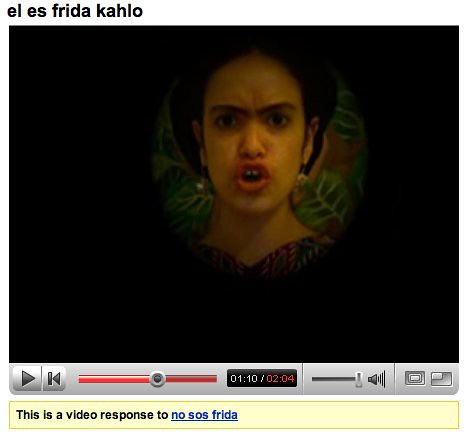 Latina artist, trying to fight the stigma of being associated with Frida Kahlo. My inclusion of these additional videos was to show the multidimensionality of the five characters initially presented in Acciones Plásticas. The Mayan women does not have her own YouTube video, but with the addition of the Be Wife video, her absence is felt even greater. The face of Guatemala in these videos, is the chest of a mail order bride. Another example can be seen within the four original videos themselves. With the grouping of the ghetto latina with the sexy latina professor, vast cultural and class difference can be seen between the two representations of Latina women. Put together with el es frida kahlo and Be Wife, there are suddenly five Latina performers all acting on one stage.
Latina artist, trying to fight the stigma of being associated with Frida Kahlo. My inclusion of these additional videos was to show the multidimensionality of the five characters initially presented in Acciones Plásticas. The Mayan women does not have her own YouTube video, but with the addition of the Be Wife video, her absence is felt even greater. The face of Guatemala in these videos, is the chest of a mail order bride. Another example can be seen within the four original videos themselves. With the grouping of the ghetto latina with the sexy latina professor, vast cultural and class difference can be seen between the two representations of Latina women. Put together with el es frida kahlo and Be Wife, there are suddenly five Latina performers all acting on one stage.
Jewish Girls from the series Acciones Plásticas
[youtube=http://www.youtube.com/watch?v=GBjBN0ftcP0]Responses to Jewish Girls
[youtube=http://www.youtube.com/watch?v=PQphBV2Q0ZE]
[youtube=http://www.youtube.com/watch?v=bGjJhIFUNGA][youtube=http://www.youtube.com/watch?v=CycyYiY933A][youtube=http://www.youtube.com/watch?v=yCM4rrhbj5U]click here to visit website
My friend Jamie Aguirre who you can visit here and here posted this wonderful Sarah Jones video for TED on my facebook page.Jones asks to what extent do we self construct?[ted id=http://www.ted.com/talks/view/id/527]I feel like a little kid in a candy store, really, I do.Here is another Sarah Jones video.[youtube=http://www.youtube.com/watch?v=VmaWDCH2tBg]Have I mentioned how amazing I think she is?Thanks Jamie!
[youtube=http://www.youtube.com/watch?v=aicKK2IkQzg][youtube=http://www.youtube.com/watch?v=6wyLF3DXK4I]
From the Vanessa Hidary the Hebrew Mamita[youtube=http://www.youtube.com/watch?v=CbZ131lXoiY]UPDATE: this post generated these responsesRIO YANEZ:
El Rio’s got The Hebrew Mamita’s back in the Bay Area, f’sho!Hidary’s ability to discuss her Jewish identity and experiences while talkin’ hella mad shit is amazing. She’s a kindred spirit to my Ghetto Frida project. After watching the videos on her youtube page I didn’t hesitate for a minute to head over to the official Hebrew Mamita online store and purchase her CD. She describes the album as “not appropriate for young children but spectacular for adults with flava!” a line I’m kicking myself for not coming up with.El Rio’s got The Hebrew Mamita’s back in the Bay Area, f’sho!
The YouTube video below is the Puerto Rican Jewess's riff on "Ga Bless You Ma." For those of you innocents, this is a common enough phrase slung at female passerby by tigueritos hanging out on the street corners of Washington Heights and other New York City 'hoods. And just in case you think I can't spell, there's nothing religious about the phrase...at least not when you say it like that.You might want to prepare for the video by rereading my earlier blog posts, "Hispanic Woman Walking" and "My Mother Wore Tight Pants".
The other day I posted a link on facebook to an article by Kevin Kelly on vizual literacy. Both Eric Repice and Eliyahu Enriquez responded to this post, and Eliyahu wrote a post about this exchange on his blog....The following is a repost of Eliyahu's post Vizual LiteracyRT/Hat Tip @mayaescobar Tools for VizualityExcerpt from Fb Thread Transcript:
In archiving poems in blog format, I find embedding videos with a distinct narrative to the word-piece heightens the sensory experience: simultaneous stimuli, rather than a replacement paradigm with regards to medium. The experimental nature of combining/utilizing moving images with poetry, such as those of Filipino Author, Nick Carbó, hints at what I'm trying to get at, though the idea I'm reaching for may be more a novelty for Literary marketing strategies/accessibility on the web... With an accompanying video in whatever length, the reader is more likely to stay with the poem, rather than a wham-bam!-thank you, sir means of creative dissection. Whereas, to capture the essence of canonization - the written word to a cinematic language, while maintaining their distinction - that's something I'm currently playing with...What Would Judas Do?
"I visited a sage, Rav Yosef Shalom Eliashuv, who lives in one of the most secluded ultra-Orthodox communities in Jerusalem. He was in poor health but still taking visitors... Speaking in Hebrew, I told him what, at the time, I felt was the truth. 'Master, I am attracted to both men and women. What shall I do?' He responded, 'My dear one, my friend, you have twice the power of love. Use it carefully' - Rabbi Steven Greenberg."
[youtube=http://www.youtube.com/watch?v=Lu2tkyEWiZc]
I am attracted to
He loved me.He loved me not.
I love bringing pleasure too
She loves mi.She loves mi knot.
The Art of Couch-Hopping
Lark descending.Lost Ark.
As Queer as A Clockwork Orange
Maya Escobar's YouTube ChannelNick Carbó's YouTube ChannelEliyahu Enriquez's YouTube Channel
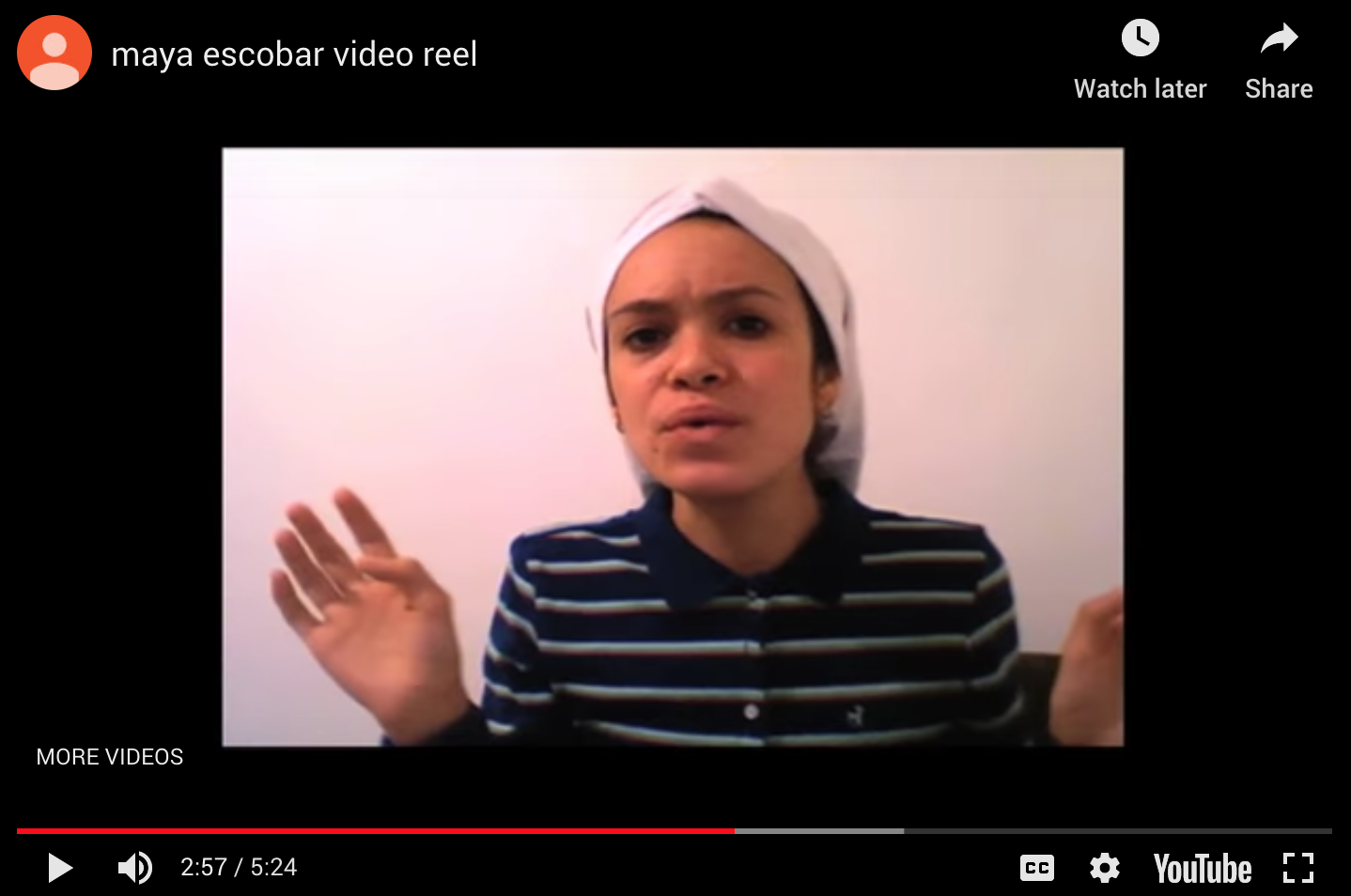
Frida Kahlo at the synagogue: Maya Escobar and the young Jewish-American Creationby David Sperber in Ma'arav Israeli Arts and Culture Magazine.translation by Shlomit NehoraiARTICLE IN SPANISH & HEBREWMaya Escobar is no doubt one of the 'hottest' things developing in the Jewish-American art scene. Escobar defines herself "dyslexic internet artist". And in order to view her work you need not wander far.Her work is mostly created in familiar internet format, and is most often displayed on Youtube. Escobar, daughter to a Jewish mother and Guatemalan father, defines her art work as ongoing personal anthropological-sociological research into the narrative language that uses contemporary media.[youtube=http://www.youtube.com/watch?v=3li_mT--f-A]The "Acciones Plasticas" work includes short films that present a series of convincing characters and monologues that deal with identity questions. In the first short film in the series she appears dressed up as the Mexican artist Frida Kahlo who became an icon within the feminist discourse. it is commonly argued that Kahlo had some Jewish roots. Escobar is dressed and made up as is famously attributed to Kahlo - the uni brow - while screaming "I am Frida Kahlo, you are Frida Kahlo, we are Frida Kahlo". In agitation or in ecstasy she tears her custom, messes up her hair, wipes her make up off of her face and returns to being herself. In another short film in the series she carries on with a monologue of a jewish orthodox woman. The text here is so exact that for a minute the line between irony and slapstick to deep seriousness is blurred. In another short film the stereotypical Latin female as a sexual sensual object is presented, when here too the subject is moving between embracing the stereotypes and breaking them. Escobar is presenting different episodes that she had experienced herself and that deal with her hybrid identity as a woman, as a Jew and as a Latin American.[youtube=http://www.youtube.com/watch?v=NNAxEUEE43Y]
Another work of Escobar is "my shtreimel" - a video-blog that is also presented on Youtube.In that piece appears a young man in his twentieths who sits in his room in front of a computer and talk about his Shabbat rituals. The monologue describes an amorphous jewish world in which jewishness lives and materializes without obligation to its institutions and mostly in personal frameworks. A central part in this world is self deprecation: The young man shows his beloved shtreimel and mentions that the shtreimel which looks like the traditional is actually a women's hat purchased at a thrift store.
In the work "eruv" (intermingling) Escobar relates to the fact that in Berlin there is no eruv even though there exists a vibrant jewish community. In a series of photographed interviews with the city's citizens she transforms the notion eruv - from a halachic-legal notion that creates a conversion of the public space into the private space, into a blending - the creation of a multiple of characters and worlds. The blending (eruv)transforms into a cultural concept that celebrates the different and the unique. The individuals create a splendid mosaic that assembles anew the "collective" as a social concept. The way Escobar deals with the subject is typical to the jewish-american art world that tends to transfer concepts from the practical halachic and transfer them to another world, and so they transform into a metaphor of the personal or social condition. The personal experience is significant to Escobar: " Like other jewish rituals, the Shabbat encompasses practicalities that materialize private condition in a private space. Except that the understanding of the private space and the public space is fluid and changes at all times. I think that it is very important that people celebrate their Shabbat as a pleasant experience, defined and personal. The Shabbat rituals evolve all the time - not as an unbending obligation that is transferred from generation to generation, but as a result of a simple choice of the individual to create to him/herself nice and pleasant Shabbat customs. We all have these kind of customs."The intercontinental use of the Internet gave birth to a generation of individuals who create for creation's sake, and the concept of art for art's sake gets that way a new meaning. The Internet media connects individuals and contributes to mutual influences between people who work separately in far away places. The young work on the Internet challenges the old definitions in relation to what is considered art and what isn't. Similarly, it adopts new presentation forms that are not the norm in the art world's mainstream, and breathes new air into the art field.The discussion into Escobar's work leads into a wider discussion about the differences between the Jewish thinking in the Israeli discourse into the new understanding of the American world view. The Jewish-artistic engagement in the United States is influenced by the introduction of new-age ideas into the center of the conversation, and is integrating into the effort to create a connection between contemporary culture and the traditional Jewish identity. Within the American-Jewish community there are signs of a move from an organized institutional Jewish expression into a unique and personal expression of the very personal experience. These artists reorganizing the traditions on their own terms, and in this way contributing not insignificantly to the definition of Jewish-American Non-Orthodox Modern-orthodox anew. The link between Jewish culture and Jewish identity to art occupies a central role in this conversation.The echoes of this tendency can be seen in Israel as well ( in the young Yiddish culture developing in Tel Aviv, for instance ), but generally there is still a deep disconnect between the dominant concepts in Israel and in the United States. In Israel it is common to connect between Judaism to an organized tradition and to a blood line that is based on a genetic continuity. On the other hand, many young Jewish-Americans marry outside their religion, but nevertheless see themselves as an integral part of the Jewish world and expect to not be expelled from it. As opposed to Israelis who experience their Jewishness in terms of disintegration that followed restoration, the Jewish-Americans create new branches where growth and rebirth metaphors fit them better.The joining of contemporary culture and art to Jewish creativity expresses itself in fashionable characteristics like tattoos, hip-hop music, Internet art and the like, and is often understood as the disconnect with the accepted binary dichotomy between holly and the common. That is why conservative bodies see these art forms as a dangerous provocation. These new cultural concepts interconnect during confrontational discussions with the old cultural concepts. Philologically speaking it can be said that borrowing symbols from one discipline to another interferes with the semiotic systems. In the Kabalistic vernacular it is said that the energy that is released during the friction that is created by the disintegration of the usual vessels - creates "new light".
a little comedic relief in the middle of thesis writing.[youtube=http://www.youtube.com/watch?v=NKMJ4uRYXPE]you too can dance with matis, other choices involve:jumping out of a plane, becoming a super hero, staring in a fairy tale, or being the hottest toy.I give him mad props for being such a skilled promoter[youtube=http://www.youtube.com/watch?v=ATdmGgPbuvU&feature=channel_page]check him out on twitter @matisyahu
Part 1 of an article I wrote for jewishinstlouis.orgEvery art student learns about the fair use principle, granting us permission to use any image in our artwork as long as we transform it so that it conveys new meaning. But beyond that all-encompassing definition, we don’t know what transgressions, if any, we are actually committing. Recently in the news is the preemptive lawsuit artist Shepard Fairey filed against the Associated Press. According to Fairey the AP threatened to sue him unless he pays royalties for the image that he used as source material for his now famous campaign poster of Barack Obama. Fairey argues that he is protected by the fair use principle. He claims that his intention was not to reproduce any particular image, but instead was to capture a specific gaze representative of the ideas of hope and change.In an interview on NPR, Fairey declared he was going forward with this suit on behalf of all artists, the thousands of artists that created their own campaign images in the same grassroots manner, pulling images from the web in support of the message of hope, change and a new administration in Washington.
Recently in the news is the preemptive lawsuit artist Shepard Fairey filed against the Associated Press. According to Fairey the AP threatened to sue him unless he pays royalties for the image that he used as source material for his now famous campaign poster of Barack Obama. Fairey argues that he is protected by the fair use principle. He claims that his intention was not to reproduce any particular image, but instead was to capture a specific gaze representative of the ideas of hope and change.In an interview on NPR, Fairey declared he was going forward with this suit on behalf of all artists, the thousands of artists that created their own campaign images in the same grassroots manner, pulling images from the web in support of the message of hope, change and a new administration in Washington.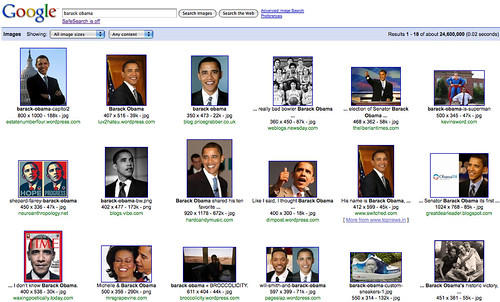
I am fascinated by Fairey’s implication that the process of appropriating and re-contextualizing Google image search results might be considered a grassroots action. As an artist, I frequently use images that that I find on Google. Like Fairey suggested, my motivation for using these images is to highlight the search itself, not the derivative image.Perhaps then, these cyber Robin Hoodian actions—using and transforming Google image search results—are capable of changing the structures that control the dissemination of information. After all, the order that information appears in Google searches is determined by the amount of people searching any given topic. And as a result of the Fairey’s appropriation, his campaign poster may be forever linked to Obama’s presidency.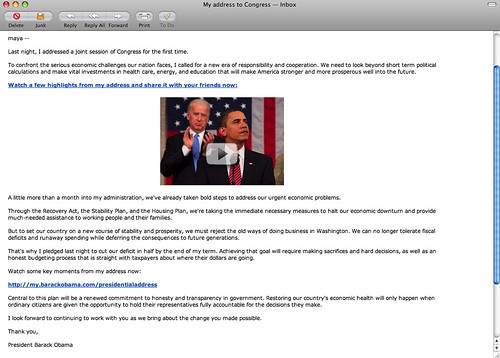
Obama’s popularity can be credited to his skillfully constructed presidential campaign that effortlessly linked his name to hope. I was quick to jump onto Obama’s online campaign message of hope. Like many others, I subscribed to his twitter, facebook, and YouTube pages. I now get weekly emails from him and I even have a blog on his site…
[youtube=http://www.youtube.com/watch?v=359HwupsY1s]This is the Jack McBrayer ResponseTo the Internet ResponseTo the Republican ResponseTo the President's Address to Congress[clearspring_widget title="Late Night with Jimmy Fallon - The Jack McBrayer Response To The Internet Response To The Republican Response To The President's Address To Congress" wid="4727a250e66f9723" pid="49a664282cffce66" width="384" height="283" domain="widgets.nbc.com"]Bobby Jindal Or Kenneth From 30 Rock?
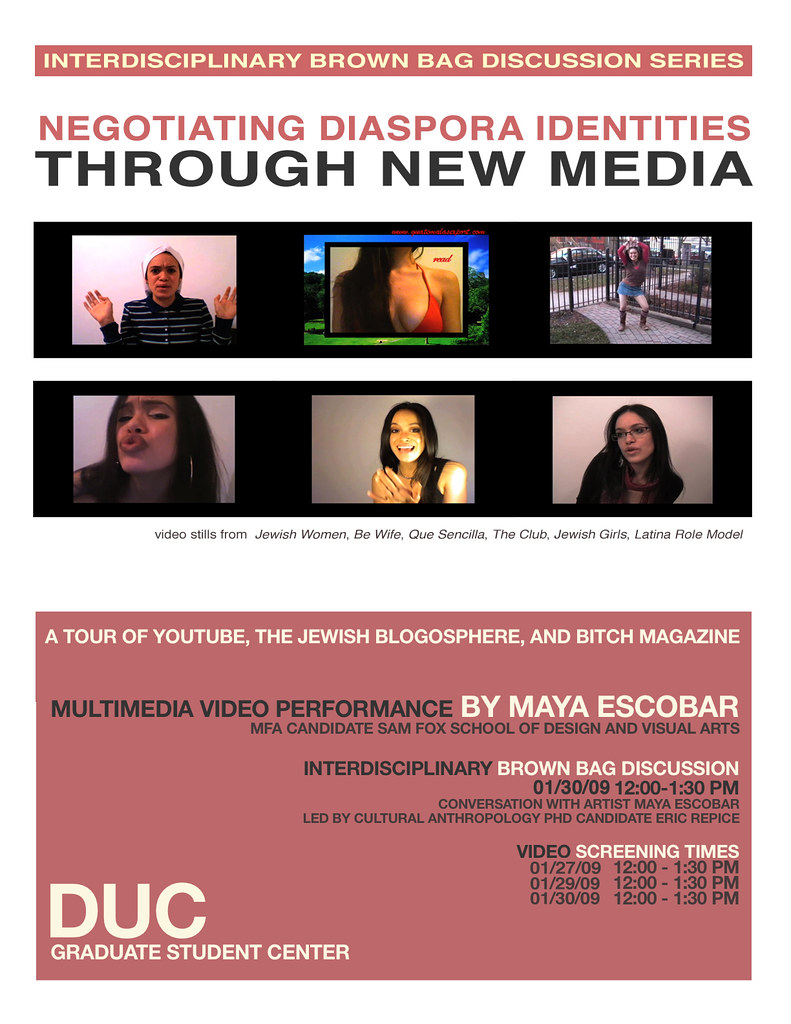 Join PhD Anthropology Candidate Eric Repice and MFA Candidate Maya Escobar in a brown bag lunch discussion concerning transnational, transcultural, and hybrid negotiations of identity through new media.How do these discussions vary between our fields?
Join PhD Anthropology Candidate Eric Repice and MFA Candidate Maya Escobar in a brown bag lunch discussion concerning transnational, transcultural, and hybrid negotiations of identity through new media.How do these discussions vary between our fields? Eric Repicefor more information on Eric Repice visit http://www.artsci.wustl.edu/~esrepice/homefor more information on Maya Escobar visit http://mayaescobar.com[youtube=http://www.youtube.com/watch?v=3li_mT--f-A][youtube=http://www.youtube.com/watch?v=G-GDmDcSH4g][youtube=http://www.youtube.com/watch?v=whLYM9o946w][youtube=http://www.youtube.com/watch?v=Vz2fhmRzCOA][youtube=http://www.youtube.com/watch?v=14bv0-dzMIc][youtube=http://www.youtube.com/watch?v=NNAxEUEE43Y]
Eric Repicefor more information on Eric Repice visit http://www.artsci.wustl.edu/~esrepice/homefor more information on Maya Escobar visit http://mayaescobar.com[youtube=http://www.youtube.com/watch?v=3li_mT--f-A][youtube=http://www.youtube.com/watch?v=G-GDmDcSH4g][youtube=http://www.youtube.com/watch?v=whLYM9o946w][youtube=http://www.youtube.com/watch?v=Vz2fhmRzCOA][youtube=http://www.youtube.com/watch?v=14bv0-dzMIc][youtube=http://www.youtube.com/watch?v=NNAxEUEE43Y]
from click for full article in artforum

The man who had just won the globe’s most visible job dominated America’s attention. President-elect Barack Obama: intelligent, witty, knowledgeable, eloquent, telegenic, photogenic, aurally pleasing. Gone, the faulty neologisms of the past eight years. Gone, the irrationality of God-directed foreign policy. Gone, the ramblings and the wacky syntax.Obama’s timely intervention into the abyss began on November 15, just eleven days after the election, when he streamed on YouTube from his website. The video opened on a modified version of the presidential seal, zooming out to reveal the words CHANGE.GOV (his website’s handle), and underneath, THE OFFICE OF THE PRESIDENT-ELECT. Then it scrolled down to the approximated presidential seal again, with these words beneath: YOUR WEEKLY ADDRESS FROM THE PRESIDENT-ELECT. NOVEMBER 15TH, 2008.This “weekly” address was in fact Obama’s very first, but enjoining “weekly” creates a faux continuity: Past activities fuse with future ones. And by issuing the podcast as the president-elect, Obama created a new, unprecedented, even extraconstitutional, national office. Still, his screen presence felt familiar, comforting. He played a role that corresponds to ones Americans have long watched on TV—from Robert Young in Father Knows Best to Sam Waterston in Law & Order (or, even more apt, Waterston in his TV ads for TD Ameritrade). The role requires unflappability, which Obama exudes like Verbena cologne, and it is his aim, in this video, to quiet America’s erratic pulse, its arrhythmic financial markets, its frightened workers, its bankrupt home owners.The president-elect is seated behind a desk on a black leather chair, his head cushioned against its back. He’s in medium shot and part of a cozy composition; nothing seems out of place. He almost appears tucked into the image, which divides into discrete elements. On the left, an American flag hangs the length of the frame, the one and only element taller than he. The background is a medium-brown wood-paneled wall. To the left of Obama, shoulder-high, three dark-blue volumes: Public Papers of the Presidents: John F. Kennedy (1961–1963). The tomes lend a somberness to the image, representing the popular, fallen president, while associating JFK’s New Frontier with Obama’s upcoming variation on the New Deal. On the far right, also shoulder height, another volume, its title blurred, and a basketball, like a Pop art sculpture, signed by Lenny Wilkens of the US Olympic basketball team. A plant’s green leaves drape over the ball.Though it’s video, it’s basically a still image. Obama wears a dark red tie and a flag pin on his gray lapel. His head moves up and down gently, for emphasis, and occasionally it subtly shifts from side to side. His expression is serious, sober, nearly unchanging, and the new gray at his temples does no harm. The sonorous Obama voice stays steady, on course, with none of the rise and fall heard in his campaign speeches, but he doesn’t shy away from unsettling language, like “the greatest economic challenge of our times.” Still, he’s not running anymore, so he’s transmuted his stump speech into a Fireside Chat, in which the screen is the hearth and his voice the melody in the air. “I know that we can steer ourselves out of this crisis. . . . I am more hopeful than ever that America will rise once again.” He has checked his radiant smile, since these are not happy times, but he reassures the American public that happy days are here to come.From this initial video message to his preinauguration press conferences to more recent YouTube clips and weekly talks, Obama has transformed the function of the president-elect, just as he transfigured the presidential campaign into an Internet phenomenon. Streaming from the Office of the President-Elect, a nonplace or anyplace, Obama proclaims his virtual presidency. The easy acceptance by the public and the media of this novel authority—after some initial “Where’s the president?” “Nowhere”—attests to the way people live today, in online encounters and communities. They connect as if they were face-to-face.Barack Obama keeps making history. He has now also affected the English language, specifically the word virtual. Through his prestidigitations, he has helped along a linguistic shift: Virtual is the new actual. And, in that sense, Obama is president, news maker, and commentator. He can explain himself, by himself. Since he knows what he’s thinking—and why—before the mediacs do, he scoops them effortlessly. In comparison with his skills, their responses seem increasingly thin, redundant, more obviously ill-informed, and excruciatingly superficial. Obama’s capacity to think and answer might force the “cult of personality” pundits to stop shouting and start reading. Actually, virtually.Lynne Tillman is a novelist.
I just re-uploaded a better quality of this video to youtube, check it out if you missed it before
Paint 4 Peace mural on ABC "The Ñ Beat," with host Theresa Gutierrez back in 2002
Paint 4 Peace is a non-profit organization comprised of artists and activists who strive to create a culture of peace, fortify communities, and bridge the gap between humanity and politics through artistic endeavors.
[youtube=http://www.youtube.com/watch?v=3li_mT--f-A&hl=en]